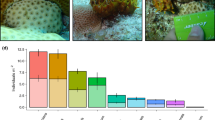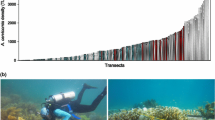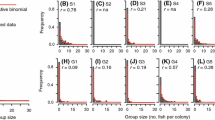Abstract
Competitive success within coral reef communities is controlled by various factors. In addition to competitive abilities in direct interactions with a contestant, external influences such as disturbance caused by nutrient input may determine the outcome of antagonistic interactions. We examined the competitive success of corallimorpharians on coral reefs by investigating their distribution patterns within reefs and how well they perform in interference competition with staghorn corals in different environments. Substrate composition and corallimorpharian growth were examined on three reefs in Tanzania under different disturbance regimes using the line-intercept transect and point techniques. A transplant experiment was conducted in which staghorn corals (Acropora formosa) were exposed to the polyps of Rhodactis rhodostoma to establish how competition between corals and corallimorpharians affects their respective distributions. Within reefs corallimorpharians seemed to be more competitive in shallow waters. This could be due to both environmental factors as well as varied competitive abilities depending on surrounding benthos that changed with depth. Reef environment also seemed to influence corallimorpharian growth among reefs as they had the highest densities in the areas with the highest nutrient loads. The transplant experiment revealed that the corallimorpharians had a competitive advantage over the corals, and in comparisons of reefs influenced by different degrees of disturbance, corallimorpharians were most competitive in the area with the highest nutrient content. Hence, stress on coral reefs in the form of raised nutrient loads may favour the competitive success of corallimorpharians.








Similar content being viewed by others
References
Alino PM, Sammarco PW, Coll JC (1992) Competitive strategies in soft corals (Coelenterata, Octocorallia) IV. Environmentally induced reversals in competitive superiority. Mar Ecol Prog Ser 81:129–145
Benayahu Y, Loya Y (1981) Competition for space among coral reef sessile organisms at Eilat. Bull Mar Sci 31:514–522
Bergman KC, Öhman MC (2001) Coral reef structure at Zanzibar Island. In: Richmond M, Francis J (eds) Marine science development in Tanzania and eastern Africa. Proceedings of the 20th Anniversary Conference on Advances in Marine Sciences in Tanzania, Institute of Marine Sciences. University of Dar es Salaam and Western Indian Ocean Marine Science Association, Zanzibar, Tanzania, pp 263–275
Björk M, Mohammed SM, Björklund M, Semesi A (1995) Coralline algae, important coral reef builders threatened by pollution. Ambio 24:502–505
Carlgren O (1949) A survey of the Ptychodactiaria, Corallimorpharia and Actiniaria. Kungl Svenska Akad Handl 1:14–16
Chadwick NE (1987) Interspecific aggressive behaviour of the corallimorpharian Corynactis californica (Cnidaria: Anthozoa): effects on sympatric corals and sea anemones. Biol Bull 173:110–125
Chadwick NE (1991) Spatial distribution and the effects of competition on some temperate Scleractinia and Corallimorpharia. Mar Ecol Prog Ser 70:39–48
Chadwick NE, Adams C (1991) Locomotion, asexual reproduction and the killing of corals by the corallimorpharian Corynactis californica. Hydrobiologia 216:263–269
Chadwick-Furman NE, Spiegel M (2000) Abundance and clonal replication in the tropical corallimorpharian Rhodactis rhodostoma. Invert Biol 119:351–360
Chadwick-Furman NE, Nir I, Spiegel M (2000) Sexual reproduction in the tropical corallimorpharian Rhodactis rhodostoma. Invert Biol 119:361–369
Chen C-LA, Chen C-P, Chen I-M (1995a) Sexual and asexual reproduction of the tropical corallimorpharian Rhodactis (= Discosoma) indosinensis (Cnidaria: Corallimorpharia) in Taiwan. Zool Stud 34:29–40
Chen C-LA, Chen C-P, Chen I-M (1995b) Spatial variability of size and sex in the tropical corallimorpharian Rhodactis indosinensis (Cnidaria: Corallimorpharia). Zool Stud 34:82–87
Cooke WJ (1976) Reproduction, growth, and some tolerance of Zoanthus pacificus and Palythoa vestitus in Kaneohe Bay, Hawaii. In: Mackie GO (ed) Coelenterate ecology and behaviour. Plenum Press, New York, pp 281–288
Done TJ (1982) Patterns in the distribution of coral communities across the central Great Barrier Reef. Coral Reefs 1:95–107
Done TJ, Potts DC (1992) Influence of habitat and natural disturbance on contributions of massive Porites corals to reef communities. Mar Biol 114:479–493
English S, Wilkinson C, Baker V (eds) (1994) Survey manual for tropical marine resources. Australian Institute of Marine Science, Townsville
Fosså AS, Nilsen AJ (1998) The modern coral reef aquarium. Bruns, Minden, Germany
Franklin H, Muhando C, Lindahl U (1998) Coral culturing and temporal recruitment patterns in Zanzibar, Tanzania. Ambio 27:651–655
Garpe KC, Öhman MC (2003) Coral and fish distribution patterns in Mafia Island Marine Park, Tanzania: fish-habitat interactions. Hydrobiologia 498:191–211
Gerald RA, Roger S (1994) Indo-Pacific coral reef field guide. Tropical Reef Research, Calendar Print, Singapore
Hamner WM, Dunn DF (1980) Tropical Corallimorpharia (Coelenterata: Anthozoa): feeding by envelopment. Micronesica 16:37–41
Hartog JC den (1980) Caribbean shallow water Corallimorpharia. Zool Verh 176:1–82
Kangwe JW (1999) The effect of land-based pollution on the reef building calcareous algae in the reefs near Zanzibar town. MSc thesis, University of Dar es Salaam, Tanzania
Karlson RH, Hurd LE (1993) Disturbance, coral reef communities and changing ecological paradigms. Coral Reefs 12:117–125
Kinsey DW, Davies PJ (1979) Effect of elevated nitrogen and phosphorus levels on coral reef growth. Limnol Oceanogr 24:935–940
Kuffner IB, Paul VJ (2001) Effects of nitrate, phosphate and iron on the growth of macroalgae and benthic cyanobacteria from Cocos Lagoon, Guam. Mar Ecol Prog Ser 222:63–72
La Barre SC, Coll JC, Sammarco PW (1986) Competitive strategies of soft corals (Coelenterata: Octocorallia) 3. Spacing and aggressive interactions between alcyonaceans. Mar Ecol Prog Ser 28:147–156
Lang JC, Chornesky EA (1990) Competition between scleractinian reef corals: a review of mechanisms and effects. In: Dubinsky D (ed) Ecosystems of the world: coral reefs. Elsevier, Amsterdam, pp 209–252
Langmead O, Chadwick-Furman NE (1999a) Marginal tentacles of the corallimorpharian Rhodactis rhodostoma 1. Role in competition for space. Mar Biol 134:479–489
Langmead O, Chadwick-Furman NE (1999b) Marginal tentacles of the corallimorpharian Rhodactis rhodostoma 2. Induced development and long-term effects on coral competitors. Mar Biol 134:491–500
Lindahl U, Öhman MC, Schelten CK (2001) The 1997/1998 mass mortality of corals: effects on fish communities on a Tanzanian coral reef. Mar Pollut Bull 42:127–131
Mbije N, Wagner GM, Francis J, Öhman MC, Bergman K (2002) Patterns in the distribution and abundance of hard corals around Zanzibar Island. Ambio 31:609–611
McClanahan TR, Arthur R (2001) The effect of marine reserves and habitat on populations of East African coral reef fishes. Ecol Appl 11:559–569
Miles JS (1991) Inducible agonistic structures in the tropical corallimorpharian Discosoma sanctithomae. Biol Bull 180:406–415
Mohammed MS, Mgaya YD (2001) Nutrients and their dynamics in the coral reefs off Zanzibar town. In: Richmond M, Francis J (eds) Marine science development in Tanzania and eastern Africa. Proceedings of the 20th Anniversary Conference on Advances in Marine Sciences in Tanzania. Institute of Marine Sciences, University of Dar es Salaam and Western Indian Ocean Marine Science Association, Zanzibar, Tanzania, pp 171–183
Muhando CA (2001) The 1998 coral bleaching and mortality event in Tanzania: implications for coral reef research and management. In: Richmond M, Francis J (eds) Marine science development in Tanzania and eastern Africa. Proceedings of the 20th Anniversary Conference on Advances in Marine Sciences in Tanzania. Institute of Marine Sciences, University of Dar es Salaam and Western Indian Ocean Marine Science Association, Zanzibar, Tanzania, pp 329–342
Muhando CA, MS Mohammed (2002) Coral reef benthos and fisheries in Tanzania before and after 1998 bleaching and mortality event. West Indian Ocean J Mar Sci 1:43–52
Muhando CA, Kuguru BL, Wagner GM, Mbije NE, Öhman MC (2002) Environmental effects on the distribution of corallimorpharians in Tanzania. Ambio 31:558–561
Muko S, Sakai K, Iwasa Y (2001) Dynamics of marine sessile organisms with space-limited growth and recruitment: application to corals. J Theor Biol 210:67–80
Mwaipopo OU (1988) Investigation of upwelling over the shelf break off Tanzanian coast. Tanz J Sci 14:118–140
Ninio R, Meekan MG (2002) Spatial patterns in benthic communities and the dynamics of a mosaic ecosystem on the Great Barrier Reef, Australia. Coral Reefs 21:95–103
Ninio R, Meekan MG, Done T, Sweatman H (2000) Temporal patterns in coral assemblages on the Great Barrier Reef from local to large spatial scales. Mar Ecol Prog Ser 194:65–74
Öhman MC, Lindahl U, Schelten CK (1999) Influence of coral bleaching on the fauna of Tutia Reef, Tanzania. In: Lindén O, Sporrong N (eds) Coral reef degradation in the Indian Ocean. CORDIO, Stockholm, pp 48–52
Parsons TM, Maita Y, Lalli CM (1989) A manual of chemical and biological methods for seawater analysis. Pergamon, Oxford
Pinto SM, da Costa Belem MJ (2000) Cnidae of two species of Discosomatidae (Cnidaria, Anthozoa, Corallimorpharia) from Brazil. Proc Biol Soc Wash 113:129–144
Rajasuriya A, Öhman MC, Johnstone RW (1998a) Coral and sandstone reef-habitats in north-western Sri Lanka: patterns in the distribution of coral communities. Hydrobiologia 362:31–43
Rajasuriya A, Öhman MC, Svensson S (1998b) Coral and rock reef-habitats in southern Sri Lanka: patterns in the distribution of coral communities. Ambio 27:723–728
Ridzwan AR (1993) Recovery processes of coral communities following the crown-of-thorns starfish, Acanthaster planci, infestations on the east coast islands of peninsular Malaysia. PhD dissertation, Newcastle University, United Kingdom
Rossi S, Snyder MJ (2001) Competition for space among sessile marine invertebrates: changes in HSP70 expression in two Pacific cnidarians. Biol Bull 201:385–393
Schmidt H (1974) On evolution in the Anthozoa. Proc 2nd Int Coral Reef Symp 2:533–560
Schmieder RW (1985) Cordell Bank expeditions, 1978–1979. Natl Geogr Res Rep 20:603–611
Sheppard CRC, Spalding M, Bradshaw C, Wilson S (2002) Erosion vs. recovery of coral reefs after 1998 El Niño: Chagos Reefs, Indian Ocean. Ambio 31:40–48
Sheppard NE (1982) Spatial distribution and the effect of competition on some temperate Scleractinia and Corallimorpharia. Mar Ecol Prog Ser 70:39–48
Shunula JP, Ngoile MAK (1990) Consequences of human activities on the marine environment of Zanzibar. In: Khan MR, Gijzen HJ (eds) Proceedings of a symposium on environmental pollution and its management in Eastern Africa. Faculty of Science, University of Dar es Salaam, Tanzania, pp 134–151
Simberloff D (1982) The status of competition theory in ecology. Ann Zool Fenn 19:241–253
Smith SV, Brock RE, Kimmerer JW, Laws AE, Walsh TW (1982) Kaneohe Bay sewage diversion experiment: perspectives on ecosystem responses to nutritional perturbation. Pac Sci 3:279–402
Sokal RR, Rohlf FJ (1995) Biometry. Freeman, New York
Spiegel M (1998) Sexual and asexual reproduction in the tropical corallimorpharian Rhodactis rhodostoma in the northern Red Sea. MSc thesis, Bar Ilan University, Ramat-Gan, Israel
Stone L, Roberts A (1991) Conditions for a species to gain advantage from the presence of competitors. Ecology 72:1964–1972
Strauss SY (1991) Indirect effects in community ecology: their definition, study and importance. Trends Ecol Evol 6:206–210
Underwood AJ (1997) Experiments in ecology: their logical design and interpretation using analysis of variance. Cambridge University Press, Cambridge
Veron JEN (1993) Corals of Australia and the Indo-Pacific. University of Hawaii Press, Hawaii
Wiens JA, Rotenberry JT (1981) Habitat associations and community structure of birds in shrubsteppe environments. Ecol Monogr 51:409–422
Williams GC (1975) Sex and evolution. Monographs in population biology. Princeton University Press, Princeton, N.J.
Williams RB (1991) Acrorhagi, catch tentacles and sweeper tentacles: a synopsis of aggression of actiniarian and scleractinian Cnidaria. Hydrobiologia 216:539–545
Woesik R van, Done TJ (1997) Coral communities and reef growth in the southern Great Barrier Reef. Coral Reefs 16:103–115
Zar JH (1996) Biostatistical analysis. Prentice-Hall International, London
Acknowledgements
The Sida/SAREC Bilateral Marine Science Programme between Sweden and Tanzania financed this study for research in marine zoology (Sida = Swedish International Development and Cooperation Agency). The Institute of Marine Sciences, Zanzibar provided research facilities. We acknowledge advice given by N.E. Chadwick-Furman. J.C. den Hartog of the Natural History Museum at Leiden, The Netherlands, assisted in identifying corallimorpharian species. Experiments performed in this study comply with the current laws of Tanzania. We thank two anonymous reviewers for providing constructive criticism of the manuscript.
Author information
Authors and Affiliations
Corresponding author
Additional information
Communicated by P.W. Sammarco, Chauvin
Rights and permissions
About this article
Cite this article
Kuguru, B.L., Mgaya, Y.D., Öhman, M.C. et al. The reef environment and competitive success in the Corallimorpharia. Marine Biology 145, 875–884 (2004). https://doi.org/10.1007/s00227-004-1376-9
Received:
Accepted:
Published:
Issue Date:
DOI: https://doi.org/10.1007/s00227-004-1376-9




